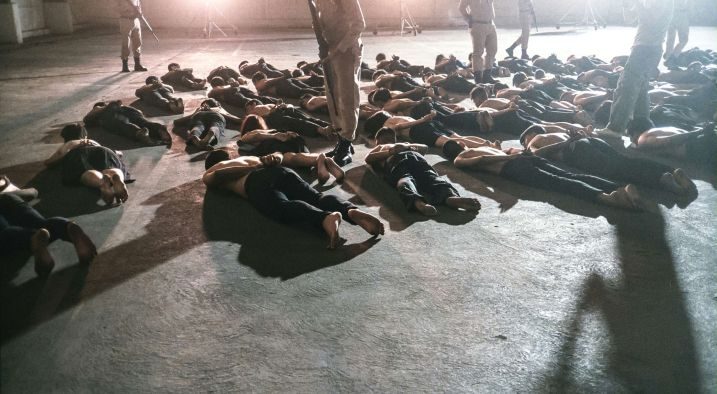Dao Khanong/ดาวคะนอง (By the Time It Gets Dark). Electric Eel Films, 2016. Directed by Anocha Suwichakornpong. In Thai. 105 minutes.
……………
I think I finally got the point when the meerkats appeared. A recurring character, a young woman who sometimes appears as the caretaker for a resort, sometimes a chef on a Chao Phraya cruise ship, sometimes a Dhammakaya initiate, but always in the same relative subordinate position vis-à-vis others, wanders through a strange sort of statue garden, where pink flamingoes, meerkats, and concrete globes repeat dizzyingly. The camera follows her past rows and rows of identical statues, pairs of repeated concrete animal eyes staring back at the screen. Here, the film clicked into place for me.
Anocha ‘Mai’ Suwichakornpong’s By the Time it Gets Dark is not a typical narrative. One might place it into the category of avant-garde Thai film in the vein of Apitchatpong Weerasethakul, but Anocha’s sensibilities are not quite Apichatpong’s. Rather than descend into Apichatpong’s surreal Isan dreamscapes, Anocha’s camera is more modern art.
Repetition – like those meerkats – is central theme of By the Time it Gets Dark — we repeat the same conversations (but with different characters in slightly different relationships), the same relationships repeat (a bland-looking film star, walking with his new lover, meets his ex arm-in-arm with a man who looks oddly similar). History repeats, Anocha tells us, and we are caught in it. As one of her characters, a former Thammasat student activist from the 1970s, says, we are not heroes of history, but rather those who have simply survived it. History washes over us in its cycles, and we simply ride it out until we can no longer.
Watching Dark is hypnotic. Part of this is Anocha’s loving attention to texture: be it the swirl of grey hair on the back of a nun’s head, or the rough wood of a rural house’s walls, part of the viewing involves getting lost in these rich details. But as we lose ourselves in these details, like a mushroom trip, once Anocha’s camera begins to reveal how these patterns repeat, one sees fractal-like repetition everywhere: a cloud of bubbles presents endless mirrored surfaces, a loaf of bread shows lines and lines of identically-shaped slices, the young woman (now a janitor) empties toilet stall after mirrored toilet stall.
But, as Derrida might have it, this repetition does not mean that each iteration is identical to the last. Here, we have decay. Significantly, when her protagonist, Ann, opens that package of repetitively-sliced bread, it is rotten. The second time we see a pair of women checking into a Northern resort, for instance, their conversations are less clear, their relationship vague. Such a sense of increasing loss emerges most clearly towards the end of the film, as Anocha’s protagonist dances awkwardly to an moronic, monotonous beat in a Bangkok club before the video cuts out in a final shattering, glorious glitch.
But there is a point to all of this. While By the Time it Gets Dark is replete with the message of the inevitability and futility of repetition, we are reminded of the repetitive cycle of Thai politics. The movie’s opening significantly reference one of Thailand’s darkest moments, drawing upon images from the 6 October massacre, a reference that is a tremendously brave move in the present political climate. The students — sometimes the students themselves, sometimes actors portraying these students (reflections within reflections) — even unfurl a banner that reads, significantly, ‘Get Out Dictator!’
For all of its other musings on identity and authorship, Dark, like Anocha’s previous Mundane History, is suffused with politics below the surface. If the prevailing motif involves reflections in cracked mirrors, the viewer is the final such mirror, in which the reality of present-day repression (in which the viewer lives) appears as a reflection of past calamity on-screen.
History repeats, Anocha seems to suggest, but for her, time is not a flat circle. Instead, it is a spiral, winding down into decay. It is a tough lesson, one that reflects a certain sense of futility and loss in present-day Thailand, and one that haunts long after the credits are over.
……………
Andrew Alan Johnson is an Assistant Professor of Anthropology at Princeton University. He is the author of Ghosts of the New City (2014, University of Hawaii Press).
Film still via Electric Eel Pictures.
 Facebook
Facebook  Twitter
Twitter  Soundcloud
Soundcloud  Youtube
Youtube  Rss
Rss 